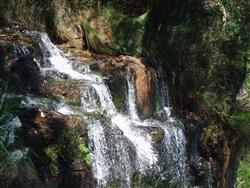Learn the fundamentals of Earth Science
Understanding Earth Science is important to many industries, from mining to meteorology and agriculture to oceanography. This will teach you about the planet you live on; and lay a valuable foundation for working in any of these industries, or progressing to study a certificate, diploma or higher qualification.
COURSE CONTENT
There are 9 lessons in this course:
 Structure and Forces
Structure and Forces - Rocks and Minerals
- Surface Changes
- The Oceans
- Air and Weather
- The Greenhouse Effect
- Global Weather Patterns
- Geological Time
- Modern Environmental Issues
Each lesson culminates in an assignment which is submitted to the school, marked by the school's tutors and returned to you with any relevant suggestions, comments, and if necessary, extra reading.
Aims:
- Describe the major structural elements of Earth and the major internal forces which affect them.
- Classify rocks and minerals according to their characteristics and formation.
- Explain external processes that that cause topographic and soil changes on the earth’s surface.
- Describe the oceans of the earth and their role in global processes.
- Describe the earth’s atmosphere and the forces which create weather.
- Describe some well known effects of particular atmospheric conditions like the Greenhouse effect.
- Identify global weather patterns and their relationship to different climates.
- Describe the way in which the earth’s surface has changed over time.
- Identify environmental issues which are of current significance.
 What you will do:
What you will do:
Research how a mountain/mountain range in or near your region was formed.
Explain plate tectonics.
Collect and classify rock samples as either sedimentary rock, igneous rock, or metamorphic rock.
Describe four ways that weathering breaks down rocks to help form soil.
Explain how the speed of a stream affects the shape of the landscape.
Name the three main layers of the ocean, describe the characteristics and ocean life in each.
Keep a record of atmospheric and weather changes in your environment.
Explain the highs and lows associated with air pressure, and how they affect weather.
Create a questionnaire to determine understanding of the Greenhouse Effect or the Ozone layer.
Explain why your region has its overall climate.
Research what life forms (plant and animal) inhabited your region before the formation of humans.
Identify the rules and laws used to date fossils.
Research an environmental problem in your area, and discuss possible solutions.
Do You Understand Earthquakes?
Over 90% of earthquakes are concentrated in a few zones or earthquake belts. The greatest release of energy through earthquakes and volcanic eruptions occurs in a belt around the Pacific Ocean, which is sometimes called the Pacific Ring of Fire. Another belt, called the Alpide Belt, runs through the mountain areas of the Mediterranean and past the Himalayas, from Java to Sumatra. A third one follows the oceanic ridge system of the Atlantic Ocean, and it is called the Mid-Atlantic Ridge.
The foci (plural from “focus”) of earthquakes (their points of origin) are described as either shallow (within 60 km of the surface), intermediate (60-300 km from the surface), or deep (more than 300 km). It is the location where fault rupture first begins and energy is released. Another name for focus is “hypocentre” (within the earth), and the “epicentre” is the focus directly above the surface (what we usually hear in the news or reports). By far the most earthquakes occur at depths of less than 100km, and all very strong earthquakes seem to be very shallow. The shallow ones generate along the divergent and transform plates (less than 100km deep) and belong to approximately 90% of all earthquake foci, whereas the deeper ones form part of only about 3% of earth’s quakes, and occur along the convergent boundaries.
The relationship between an earthquake focus and an epicentre is shown in the following illustration:
The amount of energy released during an earthquake is called its magnitude, measured by a Richter scale, which measures the energy released by an earthquake. Another scale is the Mercalli scale, which measures the effects produced by the earthquake. The greatest earthquakes ever recorded have Richter magnitudes of 8.6 and over, for example, the Largest one up to date would be the one taken place in Valdivia, Chile in 1960 with a Richter magnitude of 9.5. In general, those with a Richter magnitude of less than 2.5 (microearthquakes) are usually not felt by humans, while those with a Richter magnitude of over 5 can be classified as a risk.
Foreshocks and Aftershocks
Foreshocks are quakes which precede larger earthquakes, and may or may not occur in the same area as the large earthquake. It occurs by a minor fracturing of the rocks under pressure prior to the largest one of the series. This is called a “mainshock”. Not all earthquakes are caused by foreshocks.
Aftershocks are smaller earthquakes that occur after a main shock and may or may not occur in the same location as the mainshock. These are caused by the readjustment of the mainshock to the fault movement and they may continue for several months or years after the mainshock. Not all earthquakes are followed by aftershocks.